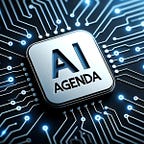Unveiling the Secrets of the Herculaneum Scrolls: A Remarkable Breakthrough
Follow Us on Instagram for video content — AI Agenda
The Herculaneum scrolls, carbonized remnants from the eruption of Mt. Vesuvius in 79 CE, have long been an enigma for scholars and historians. These scrolls, which were once deemed unreadable, have now begun to reveal their secrets, thanks to groundbreaking advancements in technology and relentless dedication from researchers.
The Momentous Revelation
The University of Kentucky’s computer science professor, Brent Seales, in collaboration with EduceLab: A Digital Restoration Initiative, the Library of the Institut de France, and the founders of the Vesuvius Challenge, recently made a historic announcement. For the first time in over two millennia, they have successfully read an entire word from the still-sealed Herculaneum scrolls. This achievement was made possible through a novel technical approach developed by Seales and his team, which played a pivotal role in recovering the ancient writing.
The Greek characters, πορφύραc, have been deciphered to mean “purple dye” or “clothes of purple.” This discovery is not just a mere extraction of characters but a testament to the potential of unlocking vast amounts of knowledge from these ancient manuscripts.
The Technical Triumph
The process of deciphering the scrolls was no small feat. The challenge was to read the Herculaneum scrolls without physically opening them. Seales embarked on this journey two decades ago, aiming to develop an artificial intelligence (AI) program capable of this task. In March, with the support of Silicon Valley investors, Seales initiated the Vesuvius Challenge. This global competition aimed to encourage researchers worldwide to build upon the AI technology and expedite the decoding process.
The results have been nothing short of astonishing. Contestants Luke Farritor and Youssef Nader have successfully virtually unwrapped multiple layers of the papyrus, revealing ancient Greek writing. Their findings have been authenticated by expert papyrologists, further solidifying the credibility of their work.
The Journey from Invisibility to Readability
The quest to unveil the secrets of the Herculaneum scrolls has been a long and intricate one:
- 2002: Seales introduced a system for “virtual unwrapping” using X-ray computed tomography.
- 2005: Seales proposed noninvasive digital methods to read the Herculaneum scrolls.
- 2016: Seales’ team developed the Volume Cartographer, a revolutionary program that could generate high-resolution images without physically opening documents.
- 2019: The team tackled the challenge of the carbon-based ink in the scrolls, which was invisible in micro-CT images. They developed a neural network to detect this unique ink.
- 2023: The Vesuvius Challenge was launched, and within six months, contestants made significant progress in decoding the scrolls.
The Future: A World of Possibilities
With the competition still ongoing and a substantial prize awaiting the winner, the race to decode the Herculaneum scrolls is heating up. The ultimate goal is to read the entire collection of these scrolls, which would arguably be the most significant discovery from the ancient world.
Seales, recognized as a leading expert in the digital restoration of cultural artifacts, remains optimistic about the future. He believes that with collective effort and technological advancements, we can conquer the seemingly impossible and bring the knowledge of the ancient world to light.
Conclusion
The Herculaneum scrolls, once considered lost to history, are now on the brink of revealing their ancient wisdom. This monumental breakthrough is not just a testament to the power of technology but also a tribute to the relentless spirit of researchers who dared to dream big. As we stand on the cusp of this new era of discovery, we are reminded of the boundless possibilities that await when determination meets innovation.
FAQs
1. What are the Herculaneum Scrolls?
- The Herculaneum scrolls are ancient papyrus manuscripts that were carbonized due to the eruption of Mt. Vesuvius in 79 CE. They were discovered in the Villa of the Papyri in the ancient Roman city of Herculaneum.
2. Why are the Herculaneum Scrolls significant?
- These scrolls are invaluable as they hold the potential to reveal a wealth of knowledge from the ancient world. They are believed to contain lost works of literature, philosophy, and other scholarly texts.
3. How were researchers able to read the scrolls without opening them?
- Researchers, led by Professor Brent Seales, developed a novel technical approach that combined X-ray computed tomography and artificial intelligence. This allowed them to “virtually unwrap” the scrolls and decipher the ancient writing without physically opening them.
4. What does the deciphered word “πορφύραc” mean?
- The Greek characters “πορφύραc” have been translated to mean “purple dye” or “clothes of purple.” This word provides insights into the possible content and context of the scrolls.
5. What is the Vesuvius Challenge?
- The Vesuvius Challenge is a global competition initiated by Professor Seales and supported by Silicon Valley investors. It encourages researchers worldwide to build upon the AI technology developed by Seales’ team to expedite the decoding process of the Herculaneum scrolls.
